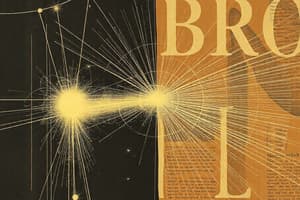Podcast
Questions and Answers
An electron has a charge of $1.6 x 10^{-19} C$.
An electron has a charge of $1.6 x 10^{-19} C$.
True (A)
Neutrons have a charge of $9.11 x 10^{31} C$.
Neutrons have a charge of $9.11 x 10^{31} C$.
False (B)
Valence electrons are located in the innermost shell of an atom.
Valence electrons are located in the innermost shell of an atom.
False (B)
Electricity is created when electrons are transferred to an object.
Electricity is created when electrons are transferred to an object.
Two positive charges attract each other.
Two positive charges attract each other.
A positive charge and a negative charge attract each other.
A positive charge and a negative charge attract each other.
The Law of Conservation of Charges states that charge can be created.
The Law of Conservation of Charges states that charge can be created.
Electrons can be created and destroyed during charging processes.
Electrons can be created and destroyed during charging processes.
Charging by induction is one of the modes of charging.
Charging by induction is one of the modes of charging.
Coulomb's Law states that the force between two charged objects is inversely proportional to the product of their charges.
Coulomb's Law states that the force between two charged objects is inversely proportional to the product of their charges.
Flashcards are hidden until you start studying
Study Notes
Electric Fields and_flux
- Electric field strength or intensity (E) is defined as the electric force per unit charge.
- Electric field lines are imaginary lines that show the direction of the electric field at a given point.
- Electric field lines:
- Point away from positive charges and toward negative charges.
- Never cross each other.
- Intersect conductors at right angles to the surface.
- Are closer together in stronger fields and farther apart in weaker fields.
Electric Flux
- Electric flux is the rate of flow of the electric field through a given area.
- Electric flux is also the number of electric field lines that intersect a given area.
- Electric flux is the amount of electric field penetrating a surface area.
- It is the product of the electric field and the area of the surface ( ΦE = E × A).
- If the electric field is perpendicular to the surface, the flux is just the product of A and E.
- If the electric field is parallel to the surface, the flux is zero.
- If the electric field makes an angle with the direction normal to the surface, the flux is proportional to the component of the field perpendicular to the surface.
Gauss's Law
- Gauss's Law states that the total electric flux through any closed surface is proportional to the total (net) electric charge inside the surface.
- The law stipulates that the total electric flux through a closed surface is only proportional to the strength of the charge inside, not the shape or size of the surface.
Charges and Particles
- Proton: +1.6 x 10^(-19) C, 1.673 x 10^(-27) kg
- Electron: -1.6 x 10^(-19) C, 9.11 x 10^(-31) kg
- Neutron: no charge, 1.675 x 10^(-27) kg
- Electric charge is created when electrons are transferred to or removed from an object.
Law of Conservation of Charges
- Charge is not created nor destroyed, but is merely transferred from one body to another.
Modes of Charging
- Charging by friction
- Charging by induction
- Charging by conduction
Studying That Suits You
Use AI to generate personalized quizzes and flashcards to suit your learning preferences.




